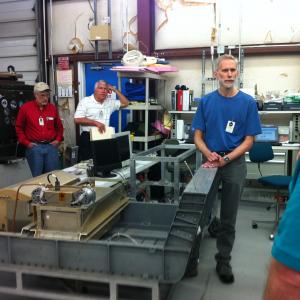Primary tabs
Nuclei-Mode Aerosol Size Spectrometer (NMASS)
The nucleation-mode aerosol size spectrometer (NMASS) measures the concentration of particles as a function of diameter from approximately 4 to 60 nm. A sample flow is continuously extracted from the free stream using a decelerating inlet and is transported to the NMASS. Within the instrument, the sample flow is carried to 5 parallel condensation nucleus counters (CNCs) as shown in Fig. 1. Each CNC is tuned to measure the cumulative concentration of particles larger than certain diameter. The minimum detectable diameters for the 5 CNCs are 4.0, 7.5, 15, 30 and 55 nm, respectively. An inversion algorithm is applied to recover a continuous size distribution in the 4 to 60 nm diameter range.
The NMASS has been proven particularly useful in measurements of nucleation-mode size distribution in environments where concentrations are relatively high and fast instrumental response is required. The instrument has made valuable measurements vicinity of cirrus clouds in the upper troposphere and lower stratosphere (WAM), in the near-field exhaust of flying aircraft (SULFUR 6), in newly created rocket plumes (ACCENT), and in the plumes of coal-fired power plants (SOS ’99). The instrument has flown on 3 different aircraft and operated effectively at altitudes from 50 m to 19 km and ambient temperatures from 35 to -80ºC.
Accuracy. The instrument is calibrated using condensationally generated particles that are singly charged and classified by differential electrical mobility. Absolute counting efficiencies are determined by comparison with an electrometer. Monte carlo simulations of the propagation of uncertainties through the numerical inversion algorithm and comparison with established laboratory techniques are used to establish accuracies for particular size distributions, and may vary for different particle size distributions. A study of uncertainties in aircraft plume measurements demonstrated a combined uncertainty (accuracy and precision) of 38%, 36% and 38% for number, surface and volume, respectively.
Precision. The precision is controlled by particle counting statistics for each channel. If better precision is desired, it is necessary only to accumulate over longer time intervals.
Response Time: Data are recorded with 10 Hz resolution, and the instrument has demonstrated response times of this speed in airborne sampling. However the effective response time depends upon the precision required to detect the change in question. Small changes may require longer times to detect. Plume measurements with high concentrations of nucleation-mode particles may be processed at 10 Hz.
Specifications: Weight is approximately 96 lbs, including an external pump. External dimensions are approximately 15”x16”x32”. Power consumption is 350 W at 28 VDC, including the pump.

